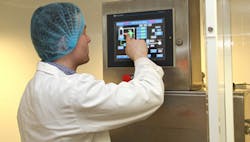Download this article in PDF format.
Microwave energy is well known (and appreciated) by anyone who has used a microwave oven to heat a meal. Such application of high-frequency electromagnetic (EM) radiation for the dielectric heating of materials is also one of the most widely adopted industrial uses for RF/microwave components and systems. Industrial microwave heating systems operate within the unlicensed industrial, scientific, and medical (ISM) frequency bands set aside by the Federal Communications Commission (FCC) for industrial applications in the U.S., such as 915 and 2450 MHz, to prevent interference with other frequency bands.
Many materials are processed by means of microwave heating, and not just for the next meal, although microwave energy is the main component of thermal processing used to eliminate bacteria in commercial food products. In agriculture, microwave energy is exploited for drying of grain and removal of moisture from wood for use as lumber. In the pharmaceutical industry, microwave energy removes the moisture from various powdered substances. In the materials supply industry, microwave energy enables the addition of different types of coatings to rubber and plastic materials.
These Innovations are Hot
For industrial applications, such as food processing, power consumption and material processing are key operating parameters toward minimizing the cost of the microwave heating or drying process. As an example, a microwave heating/drying system developed by Max Industrial Microwave uses only a small percentage of the energy required by other heating/drying systems per liter of water evaporated from the processed material, with reduced thermal processing time.
The system (Fig. 1) is designed in a compact footprint as a form of “microwave tunnel,” so that material passing through the system can be exposed continuously to microwave radiation for heating and drying. The tunnel configuration results in predictable and uniform heating of the material with minimal thermal processing times.
1. This industrial microwave heating system has a cavity that resembles a tunnel. (Courtesy of Max Industrial Microwave)
The firm supplies systems for microwave drying and sterilization at 915 and 2450 MHz. The systems can process both solid and liquid foods while preserving the essential nutrients within the food, as well as preserve its appearance and flavor. Such microwave heating/drying systems are considered “environmentally friendly” for their lack of exhaust gases and efficient use of electrical energy.
Similarly, Cellencor developed an industrial microwave oven that is about 12 feet in length with a continuous conveyer belt running through the tunnel-like structure for material samples. The system applies microwave energy to the cavity from a high-power source, using a waveguide feed to transfer EM energy to the cavity via two or more high-power, rotating antennas to achieve even heating of material samples.
Advanced Microwave Technologies is another major supplier of industrial microwave heating systems for pasteurization and food-processing applications, as well as for waste treatment and biotechnology research laboratories. Fruits and vegetables processed with the company’s systems have yielded increased shelf lives. The firm’s industrial systems are designed for fast and efficient heating of materials in a smooth production flow and with clear graphical user interface (GUI) for ease of programming and control (Fig. 2).
2. This GUI control system aids programming an industrial microwave system developed for food processing and pasteurization. (Courtesy of Advanced Microwave Technologies)
Autopack Global, which produces a variety of different material-processing systems, including induction sealers and hot-air dryers, also offers a microwave-based industrial drying system to reduce the moisture content of raw materials. It is applied to the automated drying of fruits, vegetables, meat, and fish, and even to the production of cereals such as corn flakes.
On a smaller scale, Microwave Research has a long track record of supplying microwave heating equipment at 2450 MHz for both industrial and laboratory applications. When a microwave-based heating chamber is needed for experimentation, the company offers standard microwave heating systems with as much as 3.2 kW power, although it has also developed laboratory and industrial processing systems at power levels as high as 12 kW. Many of its systems are designed according to custom requirements.
High-power microwave plasma processing is an industrial application that offers great benefits for the production of several kinds of materials, including semiconductor wafers. Microwave plasma processing (within a plasma chamber fed by a high-power microwave source) has been employed in semiconductor manufacturing for such operations as material deposition, etching, and photoresist removal. It allows dry etching of photoresist materials at high etch rates and with no ionic damage to the material samples.
Cober Inc. teamed up with high-power source supplier Muegge GmbH to develop microwave plasma ovens that are instrumental in producing advanced ceramic materials in both atmospheric and under-vacuum conditions. Non-oxide ceramic materials such as silicon nitride and tungsten carbide have been fabricated at sintering temperatures to +1700ºC with fine-detail, high-quality microstructures. Cober’s engineers also work closely with the members of the materials science department at Penn State University to develop and commercialize new microwave sintering applications.
In terms of microwave heating systems for a diversified set of applications, few suppliers can come close to Microdry Inc. As the company notes, its systems have been used for everything from cooking bacon to drying sludge, typically at frequencies of 915 or 2540 MHz. Although it offers extensive lines of standard industrial microwave systems and high-power microwave energy sources, the firm is perhaps best known for its custom system solutions, which include microwave systems for waste treatment, ore processing, and water-based adhesive drying.
Although EM energy at resonant frequencies of 915 and 2450 MHz is most often used for industrial microwave heating applications, not all suppliers of industrial EM-based heating systems subscribe to the use of those frequencies. The “Macrowave” heating systems from Radio Frequency Co. use RF rather than microwave heating to take advantage of the more uniform heating properties of the longer wavelengths. The low-frequency systems have been used to eradicate tobacco beetles when drying tobacco, and remove salmonella when pasteurizing fishmeal prior to packaging it as pet food.
For example, the company promotes the efficiency of its RF heating systems, such as its Macrowave Pasteurization Systems that operate at 40 MHz. Compared to higher-frequency microwave heating systems, the long wavelengths of these lower-frequency systems provide good depth of EM energy penetration into the material to be heated, with excellent uniformity of heating. This effectively eliminates microbes without damage to the material being heated due to prolonged exposure to high temperatures.
Sources of Power
While the systems used for microwave industrial heating may operate at the same 2450 MHz as the microwave oven that warms a cup of coffee at home, they are considerably larger and more powerful. Oftentimes, conveyer belts feed a continuous flow of materials to be processed to a large, EM-shielded chamber, where the materials are subjected to microwave energy for heating and drying. The source of that microwave energy is usually one or more continuous-wave (CW) magnetrons, using air- or water-cooled architectures to control the heat generated by the tube.
A line of CW magnetrons from the Econoco Div. of Communications & Power Industries includes models operating at fixed frequencies of 896, 915, 922, and 929 MHz (with ±10 MHz frequency variation) and as much as 100 kW output power. The magnetrons run on +19.5 to +20.0 kV anode voltage and 5.8 to 6.0 A anode current, using water cooling to maintain thermal stability even with the enormous amount of output power. With high typical efficiency of 83% to 88%, these magnetrons help achieve good operating economy in a microwave heating system by turning most of the dc input power into microwave output power.
In addition to providing the high-power microwave sources for Cober’s microwave plasma systems, Muegge GmbH is a major supplier of magnetrons that drive many other industrial microwave heating/drying applications. Suppliers of high-power CW magnetrons for industrial microwave heating applications at 915 and 2450 MHz include e2v, Hitachi High Technologies America, L-3 Technologies (formerly L-3 Communications, Electron Devices), and the aforementioned Communications & Power Industries, Econoco Div.
For repair of industrial microwave heating systems, the aptly named Industrial Microwave Systems provides replacements for many original-equipment-manufacturer (OEM) magnetrons. It offers tubes with as much as 120 kW output power at 915 MHz and 3 kW output power at 2450 MHz.
About the Author
Jack Browne
Technical Contributor
Jack Browne, Technical Contributor, has worked in technical publishing for over 30 years. He managed the content and production of three technical journals while at the American Institute of Physics, including Medical Physics and the Journal of Vacuum Science & Technology. He has been a Publisher and Editor for Penton Media, started the firm’s Wireless Symposium & Exhibition trade show in 1993, and currently serves as Technical Contributor for that company's Microwaves & RF magazine. Browne, who holds a BS in Mathematics from City College of New York and BA degrees in English and Philosophy from Fordham University, is a member of the IEEE.




